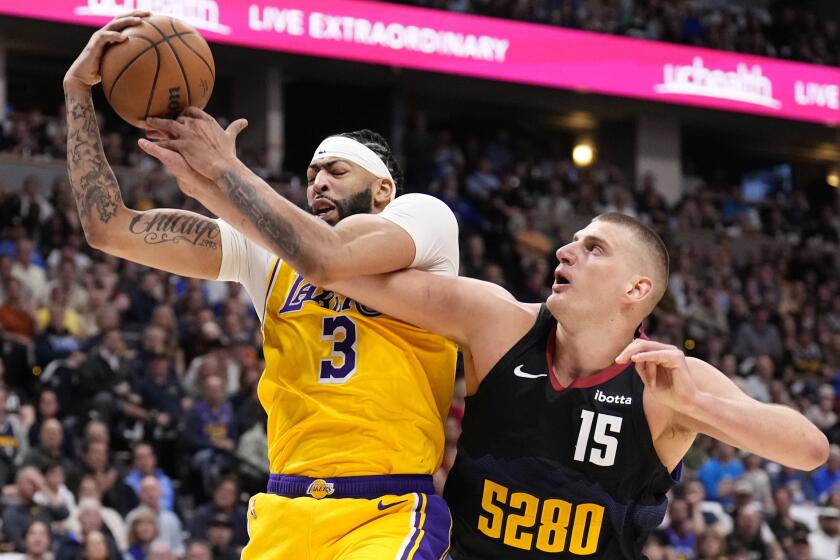1995 Tort Reform Act Said to Provide Safe Harbor for Fraud
A controversial law, passed in 1995 to curb shareholder lawsuits, is under attack for contributing to corporate fraud and possibly allowing alleged wrongdoers to avoid liability. But efforts to repeal or modify the law are meeting stiff resistance.
Consumer advocates and corporate governance experts say the tort reform legislation raised the burden of proof for lawsuits against corporations that mislead shareholders--weakening an important deterrent against corporate fraud.
Loopholes in the legislation also could allow former Enron Corp. Chief Executive Kenneth L. Lay, wayward accounting firms and other alleged scofflaws to avoid liability for shareholder losses.
“We in 1995 said this is going to create fraud like we’ve never seen before, and I would say our predictions came true,” said Sally Greenberg, a lawyer for Consumers Union.
Yet lawmakers, poised to send to the White House the most sweeping financial reforms since the 1930s, have rebuffed efforts to restore most shareholder rights lost to securities tort reform. Many of the lawmakers, both Democrat and Republican, who supported the legislation several years ago remain in Congress and continue to back their handiwork.
“It never made a good suit impossible,” said Rep. W.J. “Billy” Tauzin (R-La.), who wrote the legislation and stands behind it as he leads congressional investigations of possible corporate wrongdoing. “It was not about giving bad corporate officials any breaks. It was never about that.”
The legislation was passed as part of the pro-business, Republican-led Contract With America reforms that swept Congress in the mid-1990s under the leadership of then-House Speaker Newt Gingrich.
The legislation, called the Private Securities Litigation Reform Act, was advanced by a coalition of hundreds of large corporations, led by accounting and high-tech firms, in an effort to curtail so-called strike suits.
Lawyers were filing strike suits as soon as a stock price dropped precipitously, often without evidence of wrongdoing, corporations said. Tort reform proponents said the suits were legal fishing expeditions designed to shake down corporate targets for settlements, which could drain profitability and deter the kind of risk-taking that is essential to expand a business.
Major consumer, senior citizen and labor organizations opposed the measure, viewing it with alarm as a powerful hunk of legal kryptonite that would hurt shareholders and open U.S. markets to unprecedented chicanery. They said the regressive measure would make even the most worthy shareholder suits difficult to mount.
John Bryant, a Dallas trial lawyer and former Democratic congressman who opposed the bill, said it passed--even though many of his colleagues had reservations--in a legislative and economic environment that was almost the opposite of what it is today.
“It was completely counterintuitive to pass this bill,” he said. “It was passed in a frenzy of ideological zeal with Silicon Valley throwing gasoline on. Arthur Andersen was aggressively lobbying for this bill. Andersen was way out front.
“Everybody knew it was a bad idea, and they succeeded in overriding [then-President Clinton’s] veto and did so with the help of a lot of Democrats who were scared and running for cover. The economy was flying high, and they were afraid to be seen as not trying to help out.”
Curbing Strike Suits
But Tauzin said the bill passed with overwhelming bipartisan support because lawmakers wanted to stop strike suits, which he described as “nothing but blackmail.” He said rolling back the Private Securities Litigation Reform Act would not deter corporate crime.
Instead, Tauzin said, he supports reforms that encourage the imposition of prison time and more vigorous efforts by the Securities and Exchange Commission to force corporate criminals to pay back victims with ill-gotten gains.
“The answer is to get the money back into the hands of the corporations and the shareholders, rather than the lawyers,” he said. “When a corporation gets shaken down by strike suits, the shareholder gets hurt.”
But Bryant said increasing the prison sentences attached to corporate crimes is not enough to deter them.
“These guys don’t go pull the penal code off the wall and say, ‘Oh my goodness--the penalty has gone from five to 10 years. I’d better not do this,’ ” he said. “What they do look at is, ‘Oh my God. If I do this, I will lose everything. I better not do this.’ ”
One loophole in the ’95 reform act, known as the safe harbor provision, shields executives from liability for knowingly making overly rosy projections about their corporations--as long as they include a disclaimer. Lay and others are using the provision in their efforts to fend off shareholder lawsuits, citing it in pending motions to dismiss.
Suits on Record Pace
The fact that Enron shareholder targets are wrapping themselves in the safe harbor provision is ample reason to revisit the reform act, said Rep. Bart Stupak (D-Mich.), one of several lawmakers who have waged unsuccessful attempts to dismantle the law.
“This was their big effort to end all frivolous lawsuits,” Stupak said. “But what it really did was shred investor rights.”
Architects of the Private Securities Litigation Reform Act point to an increase in securities fraud settlement amounts as evidence that shareholders have not been shut out of the courthouse. Shareholder suits are on a record pace this year.
“In cases with real fraud, the settlements went up, and the frivolous suits are dismissed,” said Mark Gitenstein, a Washington lawyer who pushed for the law and now is representing Andersen. “There aren’t any serious changes in the PSLRA that are going to take place because there is not evidence that there should be. This argument that the PSLRA made Enron possible is ludicrous.”
Others said the rise in the number of lawsuits instead may be a measure of a greater incidence of fraud fueled, at least in part, by the handcuffs tort reform put on shareholders.
“The current spate of scandals is consistent with this argument that the 1995 act overshot in terms of its permissiveness,” said USC law professor Eric Talley, who has studied the law’s effects. “It most certainly set the table for those sorts of activities to occur.”
Prosecution Not Enough
Corporate governance experts said they were encouraged by congressional reform proposals. But, they said, improved regulation and government prosecution are not enough.
“The SEC will always have to watch too many companies to be able to really know what’s going on at every firm,” said Jennifer Arlen, a New York University law professor who specializes in securities fraud. “And one always has the problem that the SEC will be vulnerable to a kind of political pressure that plaintiffs’ lawyers are not.”
But Joseph Grundfest, a Stanford University professor and securities law expert, said it is not clear that shareholder lawsuits act as a deterrent to corporate malfeasance. Most major instances of fraud are discovered and reported by the companies or by an acquiring company, he said. And shareholder lawsuits rarely result in the perpetrators themselves paying damages.
“Shareholders get paid out of insurance policies and out of corporate coffers, so shareholders end up paying themselves out of their own corporations, and the lawyers end up getting paid a third,” Grundfest said. “The two factors that would lead to deterrence--the probability of detection and personal liability--plaintiffs’ lawyers don’t do.”
The Senate reform bill would extend the statute of limitations for shareholder suits and seek a study of enforcement efforts against accountants, investment bankers, lawyers and other corporate advisors who aided and abetted fraud. But shareholder advocates said those steps are not enough.
Sen. Richard C. Shelby (R-Ala.) proposed the study after he was unable to get a hearing on his investor protection bill, which would have repealed much of the Private Securities Litigation Reform Act.
Anti-Lawyer Sentiment
Congressional observers said securities tort reform faces several obstacles. It may be too complex, they said, for lawmakers to wade through while they are still reeling from and reacting to the Enron meltdown and subsequent almost daily announcements of new corporate accounting scandals.
Efforts also are hung up on the fact that shareholders would not be the only beneficiaries of a reform of securities litigation rules. “The anti-trial-lawyer feeling in the Congress is so great that it’s in the way,” said former SEC Chairman Arthur Levitt Jr.
The U.S. Chamber of Commerce is taking no chances. Its president and chief executive, Thomas J. Donohue, issued a statement this month saying the organization would fight attempts to “expose companies to unfair attacks by trial lawyers.”
In addition to the safe harbor shield for false corporate projections, the Private Securities Litigation Reform Act raised the bar on shareholder lawsuits by requiring plaintiffs to provide evidence at the time of filing showing how the defendants defrauded investors and that they did so with intent or reckless disregard for the truth.
The act granted defendant corporations a stay on discovery as soon as they file motions to dismiss. This took away shareholders’ primary vehicle for investigating their suspicions and created a unique Catch-22, lawyers said. Without specific evidence of the alleged wrongdoing and the defendants’ intent, shareholder suits face dismissal before they have a chance to review corporate documents that might bolster their claims.
The act also came under attack for what it left out. The reform act debate came several months after the Supreme Court, in a 5-4 decision, took away from shareholders the right--granted by the 1934 Securities Exchange Act--to name accountants, lawyers, bankers and other advisors as aiders and abettors in fraud suits. Congress restored that right to the SEC, but declined to do the same for shareholders.
Initially at least, shareholders found a way around the reform act’s higher standards, taking their grievances to state courts. But Congress shut down this end-run in 1998 with a follow-up law.







